STI Capitals
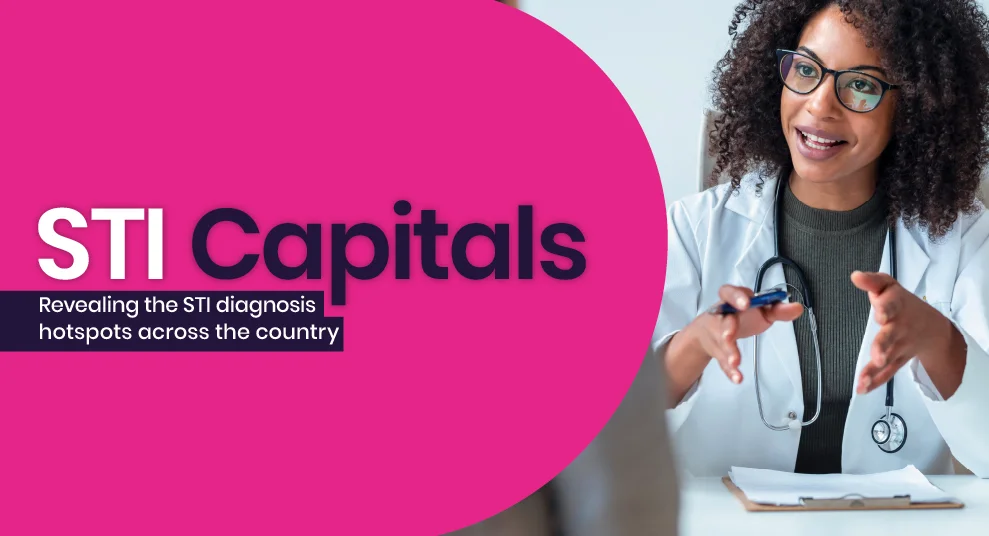
Managing our sexual health is incredibly important for any sexually active person. Being responsible by regularly testing ourselves and treating any conditions early can prevent a lot of discomfort and complications down the road, some of which can have serious long-term health impacts.
Of course, practising safe sex by using condoms or other protective measures is always recommended if you’re not in a monogamous relationship, but some risk always remains. Aside from looking out for your own well-being, being responsible when it comes to sexual health helps to prevent the spread of infections to others. After all, not all STIs are symptomatic, so without regular testing, you could still be carrying an infection without even knowing.
The good news is that digital technology has made managing your sexual health easier and more discrete than ever before. In addition to visiting a sexual health clinic, STI home test kits are now widely available across the country, and using an NHS online pharmacy has made receiving your medication as convenient as possible.
Despite the widespread access to these simple and convenient countermeasures, such as home test kits, online pharmacies and affordable protection, STIs are still a major health problem in the UK and many other countries. However, their prevalence can vary considerably from place to place, with some infections more common in one location than another.
With this in mind, we wanted to investigate the prevalence of STIs across the country, comparing new infection rates in different local authority areas to see where the health risk is greatest for those having unprotected sex. We’ve looked at the overall known STI infection rate in each area, as well as having split the data by STI to look at each one individually.
Chlamydia was the most common STI in England in 2022, with 352.40 cases per 100,000 people
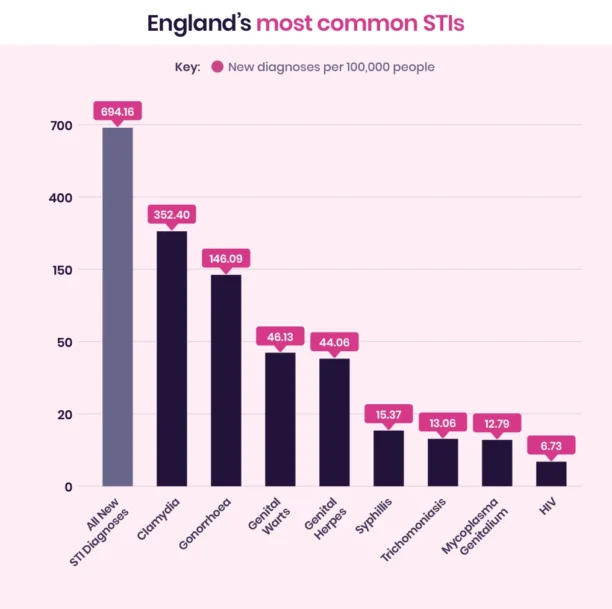
Chlamydia is by far the most common STI in England, accounting for just over half of all infections with more than 199,000 diagnoses. This is more than double that of the next most common STI, gonorrhoea, which saw 82,592 diagnoses in 2022.
Genital warts and genital herpes follow in third and fourth place, respectively, with fairly similar numbers of 26,079 and 24,910. Syphilis recorded 8,962 diagnoses across the country, while the lesser-known infections trichomoniasis and mycoplasma genitalium followed closely behind with just over 7,000 diagnoses each.
The least common STI in our study was HIV, which saw just 3,805 new diagnoses in 2022. This much lower rate is a testament to many awareness campaigns which have championed the importance of practising safe sex in more affected communities, while the widespread availability of Prep has helped to bring these numbers down even further.
With 3,573.57 new cases per 100,000 people, Lambeth has the highest STI diagnosis rate in Greater London
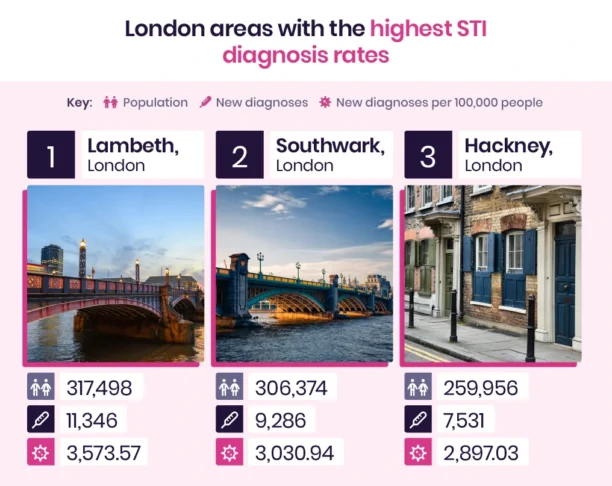
1. Lambeth New Diagnoses per 100,000: 3,573.57
Lambeth is the local authority with the highest level of new STI diagnoses in London, and in England as a whole, at 3,573.57 per 100,000 people. This means that for every 100 people, there are 3.6 infections, which is considerably higher than in any other area.
2. Southwark New Diagnoses per 100,000: 3,030.94
The local authority area with the next-highest level of STI diagnoses is Southwark, where there were 3,030.94 for every 100,000 people. Located directly next to first-place Lambeth, the high numbers of diagnoses in both local authorities suggest that this part of southern-central London is a particularly intense hotspot within the capital city.
3. Hackney New Diagnoses per 100,000: 2,897.03
In third place, with 2,897.03 new STI diagnoses per 100,000 people, is Hackney, meaning our top three local authorities are all located within Central London. In fact, all but one of the top 10 local authorities for STI diagnoses in 2022 were located within Greater London, with Lincoln being the exception in eighth place.
Bexley is the London borough with the lowest rate of STI diagnoses
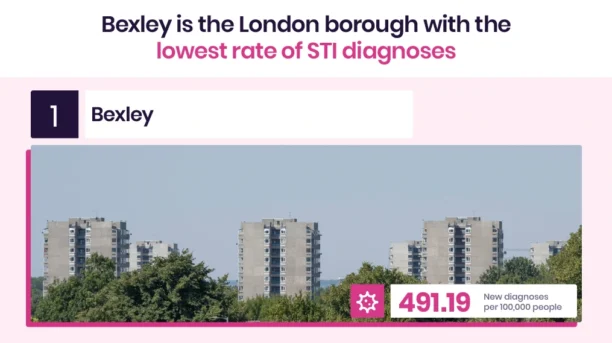
Lowest Diagnosis Rate: Bexley New Diagnoses per 100,000: 491.19
The London borough with the lowest STI diagnosis rate in the country is Bexley, where there were 491.19 diagnoses per 100,000 people. However, compared to all local authorities in England, this is still slightly higher than most, earning it 142nd place out of 295.
Lincoln has the highest STI diagnosis rate outside of London
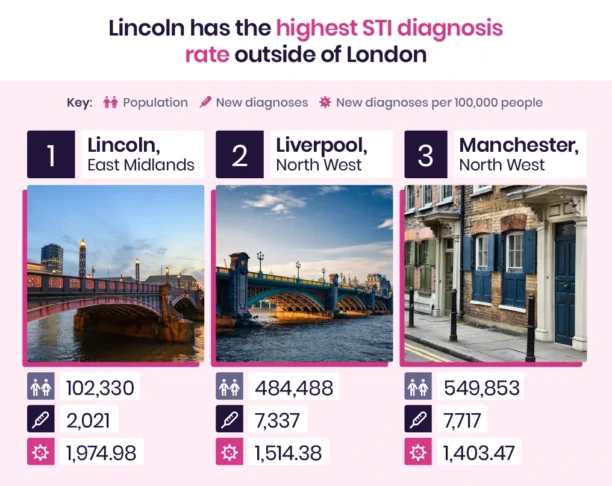
1. Lincoln New Diagnoses per 100,000: 1,974.98
Lincoln has the highest STI diagnosis rate outside of London at 1,974.98 cases per 100,000 people. This small midlands city has a total of 2,021 STI diagnoses in 2022, split across a population of 102,330, meaning approximately 2% of people reported an STI infection that year. Nearby Nottingham also scored highly, placing fourth overall, suggesting an STI hotspot in the area.
2. Liverpool New Diagnoses per 100,000: 1,514.38
Liverpool has the second-highest STI diagnosis rate outside of the capital, with 1,514.38 cases per 100,000 people. This large port city in the North West of England saw 7,337 STI diagnoses in 2022, which is far higher than first-place Lincoln, but its much larger population resulted in a lower overall rate.
3. Manchester New Diagnoses per 100,000: 1,403.47
Manchester has the third-highest rate of STI diagnoses in the country, outside of London, with 1,403.47 new cases per 100,000 people. With 7,717 new diagnoses in 2022, Manchester has the highest base number of new infections outside of London. Manchester’s high rate of diagnoses also suggests the existence of an STI hotspot in the North West’s largest cities, with Liverpool, Manchester and Salford all making the top 10.
The Isles of Scilly has the lowest STI diagnosis rate in the country
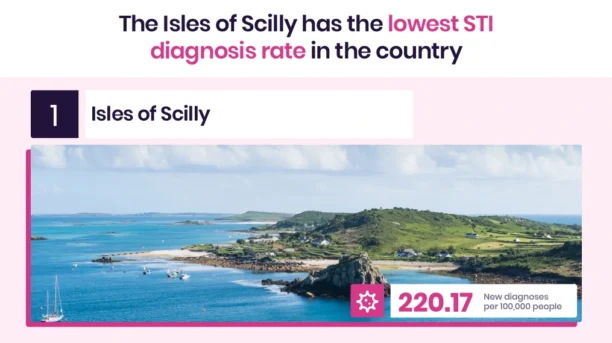
Lowest Diagnosis Rate: Isles of Scilly New Diagnoses per 100,000: 220.17
The local authority area with the lowest rate of new STI diagnoses in 2022 was the Isles of Scilly, where there were just 5 recorded new STI diagnoses. As the islands have a very low population of just 2,271 people, this translated to a normalised rate of 220.17 per 100,000. However, the mainland area with the lowest rate of STI infection was Wychavon in the West Midlands, with 244.93 diagnoses per 100,000 people.
London has the highest STI diagnosis rate, more than twice as high as any other region

Reflecting what we saw in our local authority ranking, London is the country’s STI capital, with a new diagnosis rate more than twice that of any other region at 1,397.26 per 100,000 people.
The North West is the next highest region, with 661.82 new diagnoses per 100,000 people, with the region’s hotspot, Liverpool, recording a rate of 1,514.38. Meanwhile, the other northern regions of Yorkshire and the Humber and the North East followed with rates of 608.93 and 592.38, respectively.
The East of England has the lowest overall STI diagnosis rate, with 437.75 per 100,000, with the region’s hotspot, Norwich, seeing a rate of 978.91. The only other region with an overall STI diagnosis rate below 500 was the South West, where there were 488.93 STIs diagnosed per 100,000 people.
The capital region has by far the highest population density in the country, meaning there are a lot more potential sexual partners in the area. Additionally, London has the youngest population by average age, which could mean the average Londoner is more sexually active than people in other parts of the country. These two factors combined greatly increase the risk of STI transmission, which is reflected in the much higher diagnosis rates seen in the capital, while more rural and sparsely populated areas such as the East of England and the South West saw much lower rates of infection.
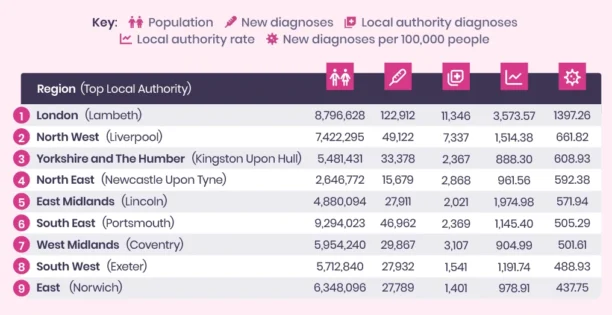
Lambeth is the London borough with the highest rate of chlamydia diagnoses
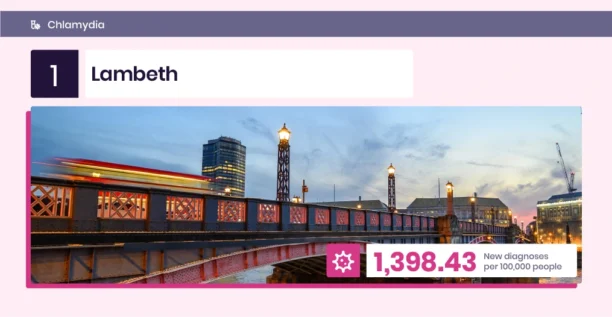
1. Lambeth New Diagnoses per 100,000: 1,398.43
Lambeth has the highest chlamydia diagnosis rate in the capital at 1,398.43 per 100,000 people, which was the second highest rate in the whole of England. Hackney followed with the next highest rate of 1,384.08 diagnoses per 100,000.
Lincoln has been named England’s chlamydia capital, with 1,608.52 new diagnoses per 100,000 people
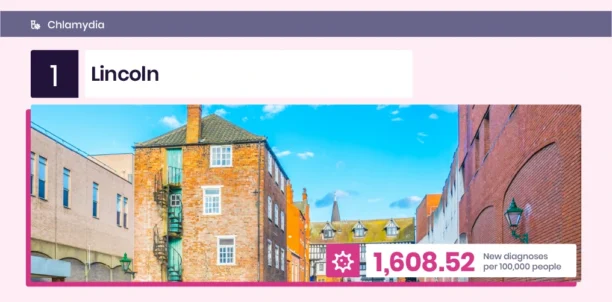
1. Lincoln New Diagnoses per 100,000: 1,608.52
The local authority with the highest rate of chlamydia diagnoses in 2022 was Lincoln, in the East Midlands, with 1,608.52 infections diagnosed per 100,000 people. Nearby Nottingham also made the top 10 with a diagnosis rate of 826.75 per 100,000, suggesting a more widespread chlamydia issue within the region.
Mid Sussex records the lowest rate of chlamydia in the country
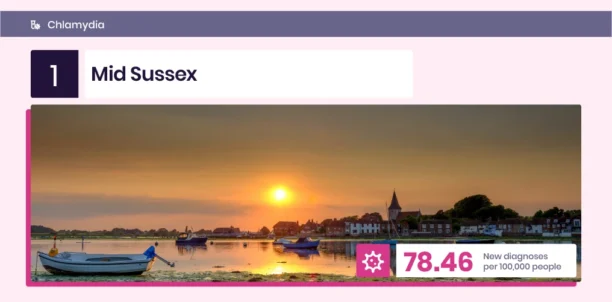
1. Mid Sussex New Diagnoses per 100,000: 78.46
The lowest rate of new chlamydia infections was recorded in Mid Sussex, with 78.46 diagnoses per 100,000 people, followed by Horsham and Adur, which are also in the South East region.
With 588.09 new diagnoses per 100,000 people, London is the region with the highest rate of chlamydia cases
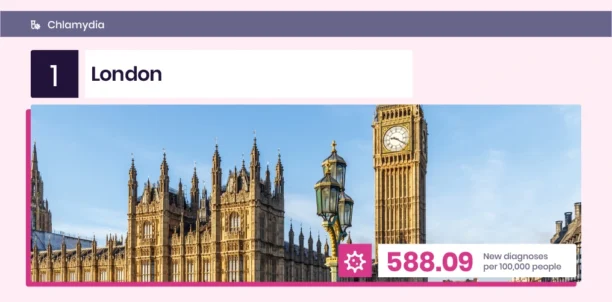
London recorded the highest rate of chlamydia diagnoses in 2022, with 588.09 infections per 100,000 people. Second place was taken by the North West, which saw a rate of 355.33 diagnoses per 100,000, with the region’s hotspot, Liverpool, recording a rate of 865.04.
Again, the East of England saw the lowest overall rate of chlamydia diagnoses at just 227.78 per 100,000 people, with Norwich recording the highest rate in the area at 500.29.
London boroughs make up the top 15 areas for gonorrhoea prevalence, with 1,220.48 new diagnoses per 100,000 people
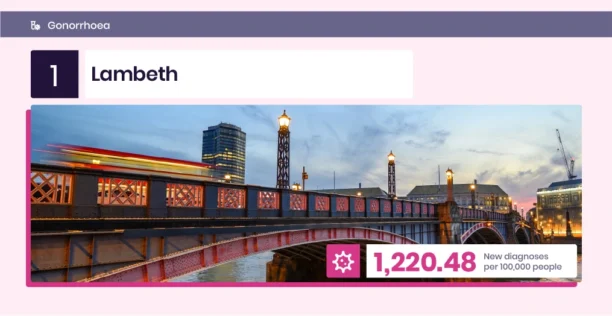
1. Lambeth New Diagnoses per 100,000: 1,220.48
Lambeth is England’s gonorrhoea hotspot, recording the highest rate of new diagnoses in 2022 at 1,220.48 per 100,000 people, with total diagnoses reaching 3,875. As with the overall STI rates, Lambeth is followed by neighbouring Southwark, where the rate of new diagnoses was recorded at 1,016.08 per 100,000 people.
No other local authority recorded a rate above 1,000, but it is worth noting that all of the top 15 local authorities for gonorrhoea were within Greater London, marking the capital as the national hotspot of new diagnoses, with Lambeth being the epicentre.
Liverpool has the highest rate of gonorrhoea diagnoses outside London
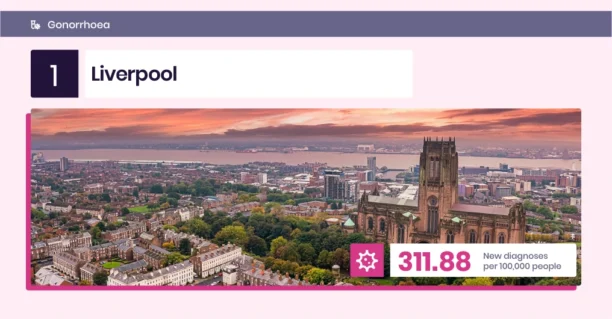
1. Liverpool New Diagnoses per 100,000: 311.88
The highest rate of gonorrhoea diagnoses outside of London was found in Liverpool, where there were 1,511 infections for an overall rate of 311.88 per 100,000 people.
The Isles of Scilly reported zero cases of gonorrhoea in 2022, the lowest rate outside of London
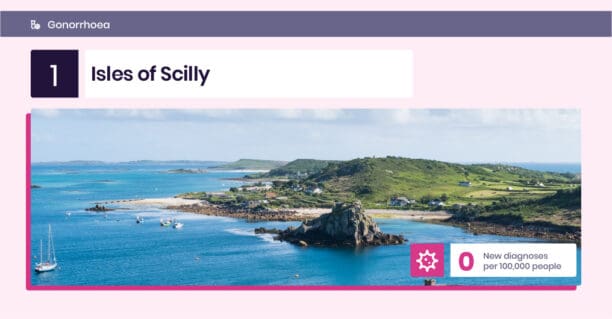
The Isles of Scilly recorded 0 cases of gonorrhoea in 2022, which is fantastic news for the area’s residents. Meanwhile, the mainland area with the lowest rate of diagnoses was North Norfolk, with 21.31 cases per 100,000 people.
Gonorrhoea is almost three times more prevalent in London than in any other region
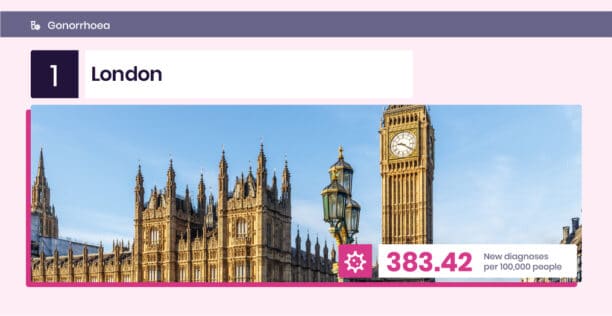
London’s rate of new gonorrhoea diagnoses is by far the highest among England’s regions at 383.42 per 100,000, which is almost triple that of second-place North West, where the rate sits at 132.57.
The other northern regions of Yorkshire and the Humber and the North East have the next highest rates of 120.37 and 117.50 diagnoses per 100,000, respectively. These regions’ hotspots are Leeds, where the gonorrhoea diagnosis rate sits at 206.17 per 100,000, and Newcastle upon Tyne, where the rate is 231.67.
The West and East Midlands regions follow next with rates just either side of 100 diagnoses per 100,000 and are in turn followed by the South East and South West. The East of England is once again the least-affected region for new diagnoses, with its hotspot, Cambridge, recording a rate of 153.41 per 100,000.
Hammersmith and Fulham is England’s genital warts hotspot, with 151.12 new diagnoses per 100,000 people
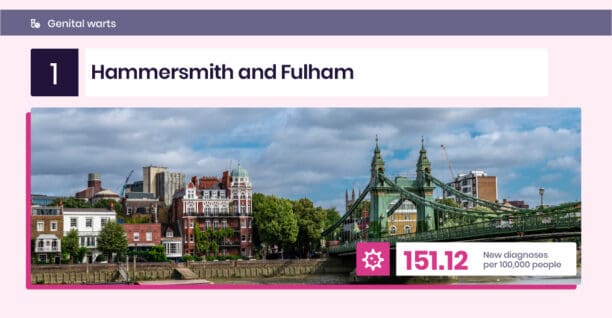
1. Hammersmith and Fulham New Diagnoses per 100,000: 151.12
Hammersmith and Fulham has the highest rate of genital wart diagnoses in England at 151.12 cases per 100,000 people. This is followed by Lambeth, with 146.14 per 100,000, and Wandsworth, with a rate of 136.74. London local authorities make up all of the top 10 areas and 17 of the top 20.
Brighton and Hove has the highest rate of genital wart diagnoses outside Greater London
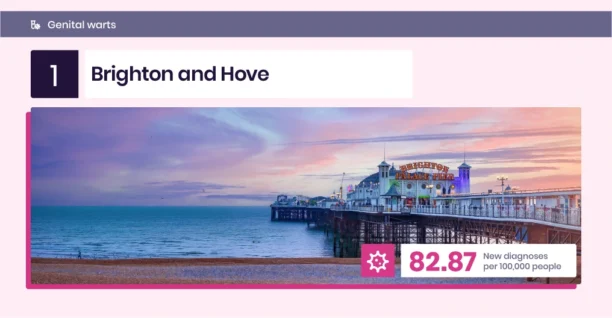
1. Brighton and Hove New Diagnoses per 100,000: 82.87
Outside of London, genital wart diagnoses were most common in Brighton and Hove, which took 13th place overall with a rate of 82.87, while Bristol and Norwich, which placed 15th and 20th, respectively, had the next highest rates of 80.87 and 74.06 per 100,000.
Isles of Scilly saw the lowest rates of genital warts diagnoses
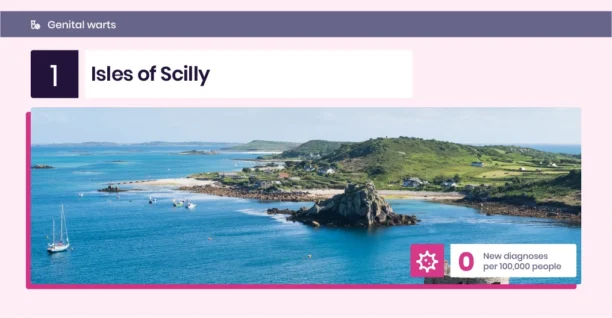
While the Isles of Scilly didn’t record a single new case of genital warts in 2022, the mainland area with the lowest diagnosis rate was Solihull, in the West Midlands, where there were just 13.85 diagnoses per 100,000 people.
Genital warts are most common across England’s southern regions, particularly London
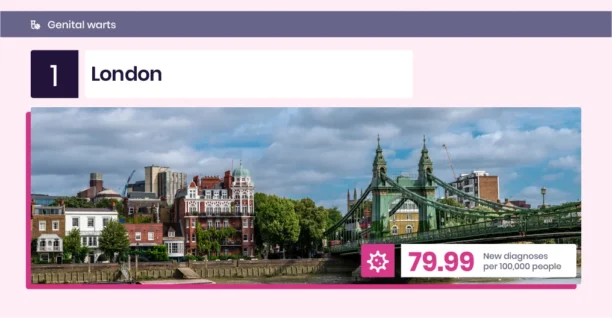
London once again takes the top spot as the region where genital warts are most prevalent, with a diagnosis rate of 79.99 per 100,000 people. The South East then follows with the second highest rate of 42.44, while the South West takes third place with a rate of 41.59 diagnoses per 100,000 people.
The West Midlands has the lowest rate of genital warts diagnoses at 32.31 per 100,000 people, with the region’s hotspot, Redditch, recording a rate of 57.47. The North East also recorded a very low overall rate of genital warts at 33.74 per 100,000, with the region’s hotspot, Newcastle upon Tyne, seeing a rate of 46.60.
Southwark is the biggest genital herpes hotspot in the country
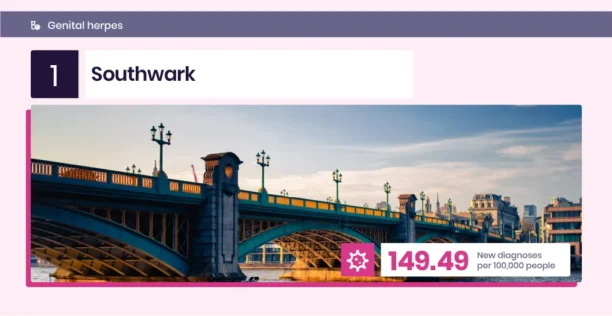
1. Southwark New Diagnoses per 100,000: 149.49
Southwark takes the top spot once again, this time for the highest rate of genital herpes diagnoses in England, with a rate of 149.49 per 100,000 people. Southwark is followed closely by Lambeth in second place, where the rate was 149.29 diagnoses per 100,000, while Hammersmith and Fulham took third place with a rate of 141.85. The top 12 local authorities for genital herpes diagnoses were in London.
Exeter saw the highest rate of genital herpes outside the capital

1. Exeter New Diagnoses per 100,000: 88.94
The highest genital herpes diagnosis rate outside of the capital was recorded in Exeter, placing 13th overall with 88.94 diagnoses per 100,000 people. However, the North West region saw three local authorities make the top 20, including Blackpool and Liverpool, which directly followed Exeter with diagnosis rates of 83.01 and 82.77, respectively.
The Isles of Scilly had the lowest rate of genital herpes diagnoses, with no new diagnoses in 2022
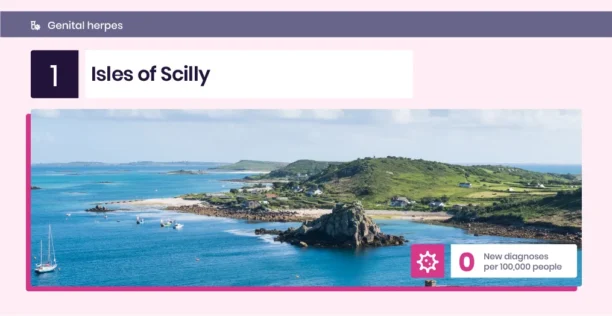
Again, the Isles of Scilly recorded no new diagnoses of genital herpes in 2022. The mainland area with the lowest rate of genital herpes diagnoses was Blackburn with Darwen, in the North West, where there were just 15 reported cases and a rate of 9.68 per 100,000 people.
London has the highest genital herpes rate, followed by the North West
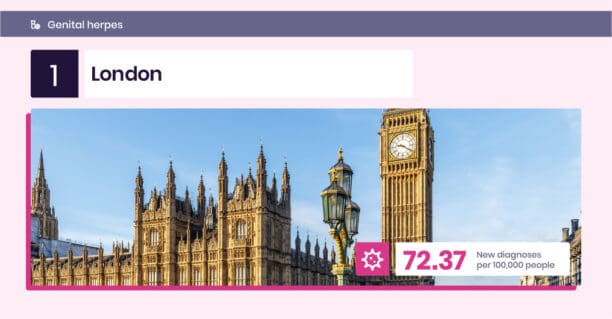
London recorded the highest rate of genital herpes diagnoses in the country, with 72.37 per 100,000. The North West and North East regions had the next highest rates, 42.29 and 38.65, respectively. Blackpool saw the highest rate of genital herpes diagnoses in the North West at 83.01, while Newcastle upon Tyne has the highest rate in the North East at 62.70.
The South East, East Midlands and Yorkshire and the Humber were all close behind the North East, with rates hovering around 38 diagnoses per 100,000, while it dropped slightly in the South West and East regions to just over 36.
The region with the lowest rate of genital herpes diagnoses was the West Midlands, which recorded 31.64 cases per 100,000 people. Nuneaton and Bedworth saw the highest rate in the region at 53.61 diagnoses per 100,000.
Lambeth has the highest syphilis rate in the country, with London fielding the top 10 areas
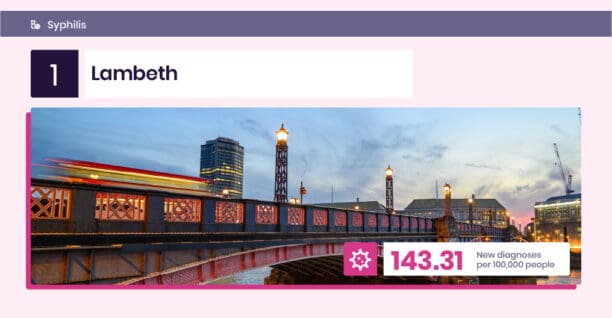
1. Lambeth New Diagnoses per 100,000: 143.31
Lambeth takes the national top spot for syphilis diagnoses, with 143.31 diagnoses recorded per 100,000 people in 2022, and only two other local authorities saw rates higher than 100. The first of these is Southwark, which took second place with a rate of 133.17 diagnoses per 100,000, while Westminster took third place with a rate of 128.24. A total of 16 of the top 20 local authorities for syphilis were within Greater London.
The highest rate of syphilis diagnoses outside London was in Brighton and Hove

1. Brighton and Hove New Diagnoses per 100,000: 53.92
Brighton and Hove saw the highest syphilis diagnosis rate outside London at 53.92 per 100,000 people. This was followed by Salford, with a rate of 45.43; Middlesbrough, with 44.53; and Manchester, with 42.92 diagnoses per 100,000.
Rother and the Isles of Scilly both reported zero new cases of syphilis in 2022
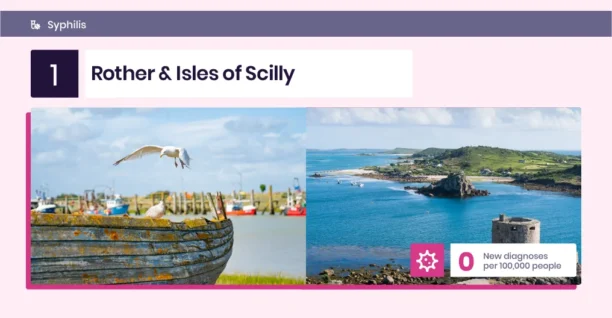
Both the Isles of Scilly and the Rother, in the South East, recorded no new cases of syphilis in 2022, while 10 other local authorities recorded just a single case. Almost half of local authorities recorded 10 cases or fewer.
London’s syphilis rate is more than three times higher than second-place North East
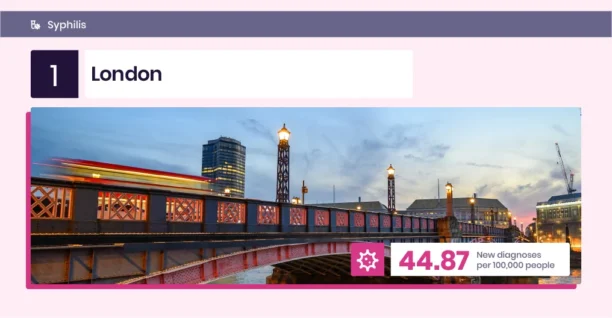
London’s syphilis rate is the highest in the country at 44.87 diagnoses per 100,000, which is more than three times that of second place North East, where the rate stands at 14.85 cases per 100,000 people. The North West and West Midlands are the only other regions where the diagnoses rate was greater than 10 per 100,000, with rates of 12.70 and 10.65, respectively.
The South West saw the lowest rate of syphilis diagnoses at 6.07 per 100,000 people, with the region’s hotspot, Bristol, recording 13.16 cases per 100,000. The East Midlands had the second lowest regional diagnoses rate at 7.58, with its highest rate of 16.59 recorded in Nottingham, while cases in the East of England were slightly more common at 7.83 per 100,000.
The rate of trichomoniasis infections is highest in Croydon, with 109.09 new diagnoses per 100,000 people
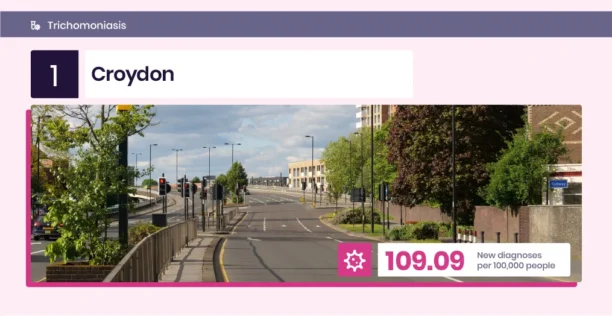
1. Croydon New Diagnoses per 100,000: 109.09
Croydon saw the highest rate of trichomoniasis diagnoses in the country at 109.09 per 100,000 people. Croydon was followed by Hackney, with a rate of 99.04, with Lambeth being the London borough with the third highest rate at 74.96 diagnoses per 100,000.
Sandwell records the highest rate of trichomoniasis diagnoses outside London
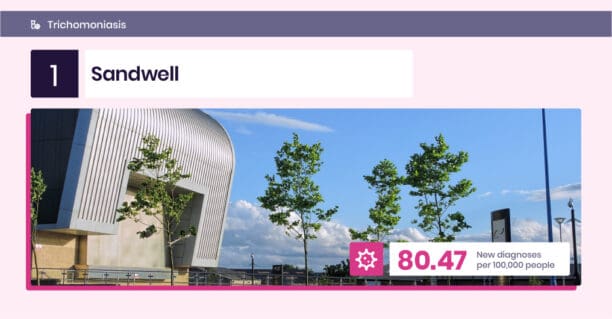
1. Sandwell New Diagnoses per 100,000: 80.47
Sandwell, in the West Midlands, recorded the highest trichomoniasis diagnosis rate outside the capital, with 80.47 diagnoses per 100,000. Neighbouring Wolverhampton had the second highest rate with 49.99 diagnoses per 100,000, suggesting a combined hotspot with a degree of crossover.
England’s trichomoniasis hotspots appear to be more evenly spread than those of other STIs, with nine of the top 20 local authorities being outside Greater London, though this still means that the majority are within the capital. Interestingly, not one of the top 20 areas is located within the more northerly regions of the North West, North East or Yorkshire and the Humber.
12 local authorities recorded zero new diagnoses of Trichomoniasis in 2022
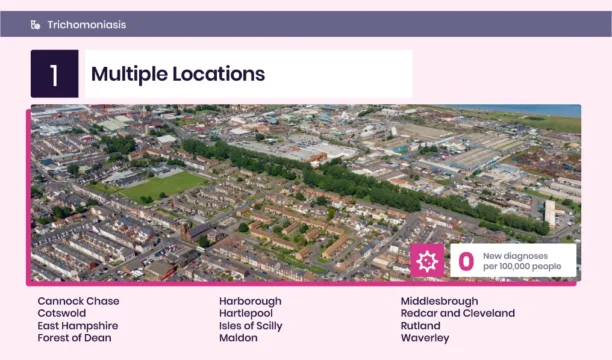
A total of 12 local authorities recorded no trichomoniasis infections in 2022, including the likes of Hartlepool, Maldon, Harborough and Waverley. As many as 19 areas reported just one new case of trichomoniasis, while more than half of England’s local authorities reported fewer than 10 cases.
London and the West Midlands are the regions with the highest rates of trichomoniasis

London is the region with the highest rate of trichomoniasis diagnoses at 32.50 per 100,000, while the West Midlands follows in second place with a rate of 16.90, which is still much higher than all other regions. Yorkshire and the Humber and the East of England have the next highest rates at 9.63 and 9.47 per 100,000, respectively.
The South West has the lowest rate of new trichomoniasis diagnoses at 4.97 per 100,000, with the region’s hotspot, Gloucester, recording a rate of 16.6. Trichomoniasis is only a fraction more prevalent in the North East, where there are 5.29 diagnoses per 100,000, with Sunderland recording the highest rate in the region at 12.4.
With 90.02 new diagnoses per 100,000 people, Hammersmith and Fulham has the highest rate of mycoplasma genitalium
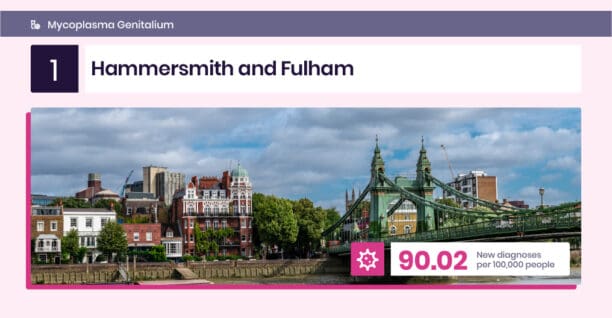
1. Hammersmith and Fulham New Diagnoses per 100,000: 90.02
Hammersmith and Fulham recorded the highest rate of mycoplasma genitalium (MG), with 90.02 diagnoses per 100,000 people. Lambeth follows in second place with 84.10 diagnoses per 100,000, while Kensington and Chelsea comes third with a diagnosis rate of 81.28. Nine of the top ten local authorities for MG diagnoses are in London.
Liverpool saw the highest rate of mycoplasma genitalium diagnoses outside Greater London
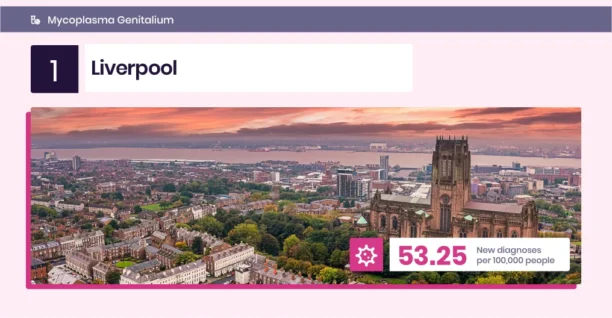
1. Liverpool New Diagnoses per 100,000: 53.25
Liverpool had the highest rate of MG diagnoses outside London, with a rate of 53.25 diagnoses per 100,000 people. Of the top 20 local authority areas, a total of five were outside Greater London, with the other four being Sunderland, Norwich, Kingston upon Hull and Brighton and Hove.
Ribble Valley, Warwick, Middlesbrough, and 15 other local authorities reported zero cases of mycoplasma genitalium
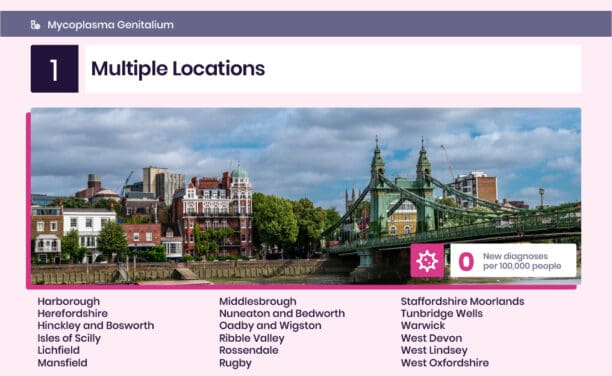
As many as 18 separate areas reported no diagnoses of MG, including the Ribble Valley, Warwick, Lichfield, Middlesbrough and Tunbridge Wells, while 11 areas reported just a single case each. Half of all local authorities in England reported 10 cases or fewer.
The East of England has the highest rate of mycoplasma genitalium outside Greater London
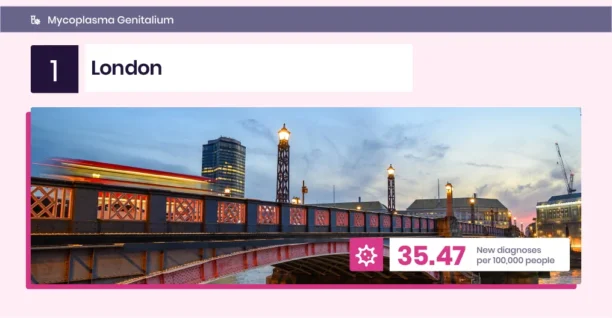
London reported the highest rate of mycoplasma genitalium (MG) in the country, with a rate of 35.47 diagnoses per 100,000 people. This is approximately three times that of the East of England, which took second place with a rate of 12.84 per 100,000.
The North West and North East are the only other regions to record rates higher than 10, with 11.44 and 11.33 diagnoses per 100,000, respectively. The South East saw the next highest rate of MG diagnoses at 8.94 per 100,000, with Yorkshire and the Humber following with 7.63 diagnoses per 100,000.
The East Midlands had the lowest diagnosis rate at 3.63 per 100,000 people, with the region’s hotspot, Chesterfield, recording a rate of 15.43. Also on a very low overall diagnosis rate of 3.78 was the West Midlands, with the area’s highest rate of 9.02 being found in Birmingham.
Westminster is the local authority with the highest rate of new HIV diagnoses per 100,000 people
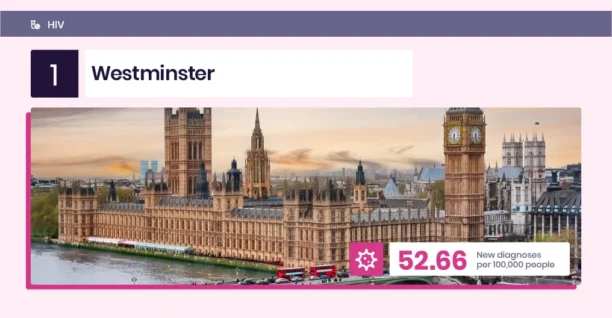
1. Westminster New Diagnoses per 100,000: 52.66
The local authority with the highest rate of new HIV diagnoses in England is Westminster, with 52.66 new HIV cases per 100,000 people. The second-highest rate of new diagnoses was seen in Kensington and Chelsea, where it sits at 35.43 per 100,000, while Lambeth takes third place with a rate of 34.65.
Cambridge saw the highest rate of new HIV diagnoses outside of Greater London
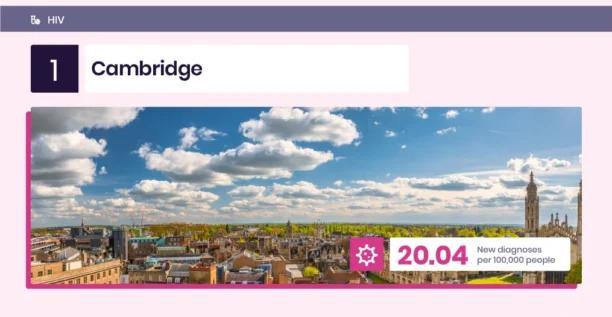
The top seven local authorities for new HIV infections are all located in the capital, along with 15 of the top 20. The exceptions here are Cambridge, which took eighth place with a rate of 20.04, as well as Nottingham, Manchester, Leeds and Southampton.
13 local authorities including Tamworth, Pendle and Brentwood recorded no new HIV diagnoses in 2022

There were 13 local authorities that recorded no new HIV diagnoses in 2022, including Pendle, Tamworth, Rochford and Brentwood, while a further 23 local authorities recorded just a single case. As many as 200 local authorities reported 10 or fewer new HIV diagnoses, accounting for over two-thirds of areas in England at 67.57%.
New HIV diagnoses are most common in London, followed by Yorkshire and the Humber
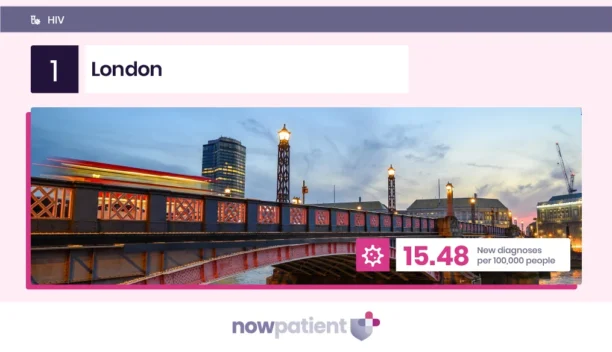
London saw the highest number of new HIV diagnoses, with a rate of 15.48 per 100,000 people. This is more than double any other region, with Yorkshire and the Humber taking second place with a rate of 6.51, which was closely followed by the East Midlands, where the rate sits at 6.11 per 100,000.
New HIV diagnoses were least common in the South West, which recorded a rate of 3.15 cases per 100,000. Swindon was the regional hotspot in the South West, with 7.27 cases per 100,000. Recording a rate just slightly higher than the South West, the North East also recorded a very low rate of new HIV diagnoses at 3.66 per 100,000, with the highest figure of 9.12 seen in Sunderland.
Methodology
We wanted to analyse the prevalence of STIs across the country, revealing the local authorities and regions with the highest rates of new infections. To do this, we used NHS data, which revealed the number of diagnoses in each local authority in 2022 for a range of different STIs, as well as providing an overall figure. We compared this to population data for each local authority to calculate a normalised rate of diagnoses (per 100,000).
Each local authority was then assigned its region, with a combined figure calculated for each, to compare how STI diagnosis rates differed at a regional level. Data was only available for England, so the other countries of the United Kingdom were not included in this study.
Data for the City of London was not included in the comparison of local authorities, as the very small population compared to the number of people who work in the area and access its health services would have skewed the data. However, we did include the City of London in the London region when conducting our regional analysis.
All diagnosis rates were rounded to two decimal places before ranking.
NowPatient is an online pharmacy & telehealth service that is available in the US and UK. Our service is FREE and packed with useful features that can help you save money on the cost of your medications, access virtual treatments, and provide tools that can help improve your overall health. Get started today and benefit from medication reminders, private treatment plans, NHS online pharmacy, GP appointment booking, Rx savings card, Drug Coupons, US drug savings programs, health conditions information, genetic testing, home test kits, BMI Risks, Type 2 Diabetes Risks, pollen meter, air quality monitor, and lots more!
Medical Disclaimer
NowPatient has taken all reasonable steps to ensure that all material is factually accurate, complete, and current. However, the knowledge and experience of a qualified healthcare professional should always be sought after instead of using the information on this page. Before taking any drug, you should always speak to your doctor or another qualified healthcare provider.
The information provided here about medications is subject to change and is not meant to include all uses, precautions, warnings, directions, drug interactions, allergic reactions, or negative effects. The absence of warnings or other information for a particular medication does not imply that the medication or medication combination is appropriate for all patients or for all possible purposes.





